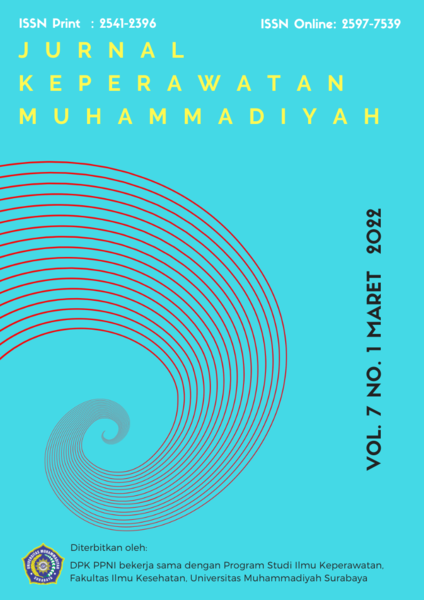Perbedaan Pengaruh Myofascial Release Dan Neuro Development Treatment Terhadap Penurunan Spastisitas Pada Regio Hip, Knee Dan Ankle Anak Cerebral Palsy Spastik Diplegi Di UPT Pusat Layanan Disabilitas Kota Blitar
DOI:
https://doi.org/10.30651/jkm.v7i1.11018Kata Kunci:
cerebral palsy, myofascial release, neuro development treatmentAbstrak
Objective: Â To determine the difference between myofascial release and neuro development treatment in reducing spasticity in children with diplegic spastic cerebral palsy.
Methods: The number of samples in this study were 20 respondents, which were divided into 2 groups, namely myofascial release and neuro development treatment. The measurement of spasticity in this study uses the Ashworth scale measuring instrument.
Results: The results of the wilcoxon test proved that myofascial release had no effect on decreasing spasticity with a p value of 0.083 (p>0.05) in the hip region, p 0.083 (p>0.05) in the knee region and p value 1,000 (p>0.05) in the ankle region, while neuro development treatment had an effect on decreasing spasticity with p value 0.008 (p<0.05) in the hip region, p value 0.005 (p<0.05) in the knee region and p value 0.007 (p<0.05) in the ankle region ankles. The results of the mann-whitney test prove that there is a significant difference in the effect of myofascial release and neuro development treatment on reducing spasticity with a p value of 0.000 (p <0.05).
Conclusion: There is a significant difference between myofascial release and neuro development treatment on reducing spasticity in children with spastic cerebral palsy diplegia.Referensi
Abidin, Z., Kuswardani, K., & Purnomo, D. (2017). Pengaruh Terapi Latihan Metode BOBATH Terhadap Cerebral Palsy Diplegi Spastic. Jurnal Fisioterapi Dan Rehabilitasi, 1(1), 16–23. https://doi.org/10.33660/jfrwhs.v1i1.6
Anindita, A. R., & Apsari, N. C. (2020). Pelaksanaan Support Group Pada Orangtua Anak Dengan Cerebral Palsy. Focus : Jurnal Pekerjaan Sosial, 2(2), 208. https://doi.org/10.24198/focus.v2i2.26248
Burhaein, E. (2017). Aktivitas Fisik Olahraga Untuk Pertumbuhan Dan Perkembangan Siswa SD. Indonesian Journal of Primary Education, 1(1), 51–58.
Fidan, F., & Baysal, O. (2014). Epidemiologic Characteristics of Patients with Cerebral Palsy. Open Journal of Therapy and Rehabilitation, 02(03), 126–132. https://doi.org/10.4236/ojtr.2014.23018
Park, E. Y., & Kim, W. H. (2017). Effect Of Neurodevelopmental Treatment-Based Physical Therapy On The Change Of Muscle Strength, Spasticity, And Gross Motor Function In Children With Spastic Cerebral Palsy. Journal of Physical Therapy Science, 29(6), 966–969. https://doi.org/10.1589/jpts.29.966
Pitari, R. R. A. B. (2018). Pengaruh Pemberian Metode Myofascial Release Otot Gastrocnemius Terhadap Penurunan Spastisitas Dan Fungsional Berdiri Pada Cerebral Palsy Spastik.
Ramadhani, N. A. S. (2016). Pengaruh Kombinasi Massage Dan Neuro Development Treatment ( NDT ) Terhadap Kemampuan Postural Duduk Pada Anak Cerebral Palsy Tipe Spastic.
Whisler, S. L., Lang, D. M., Armstrong, M., Vickers, J., Qualls, C., & Feldman, J. S. (2012). Effects Of Myofascial Release And Other Advanced Myofascial Therapies On Children With Cerebral Palsy: Six Case Reports. Explore (New York, NY), 8(3), 199–205.
Yani, F. A. (2017). Pemberian Neurodevelopmental Therapy (NDT) Dalam Meningkatkan Keseimbangan Berdiri Pada Cerebral Palsy Spastik Diplegi. Universitas Pembangunan Nasional Veteran Jakarta.
Unduhan
Diterbitkan
Terbitan
Bagian
Lisensi
- Penulis tetap memegang hak atas karyanya dan memberikan hak publikasi pertama kepada jurnal ini yang secara simultan karya tersebut dilisensikan di bawah:Â Creative Commons Attribution-ShareAlike 4.0 International (CC BY-SA 4.0)













